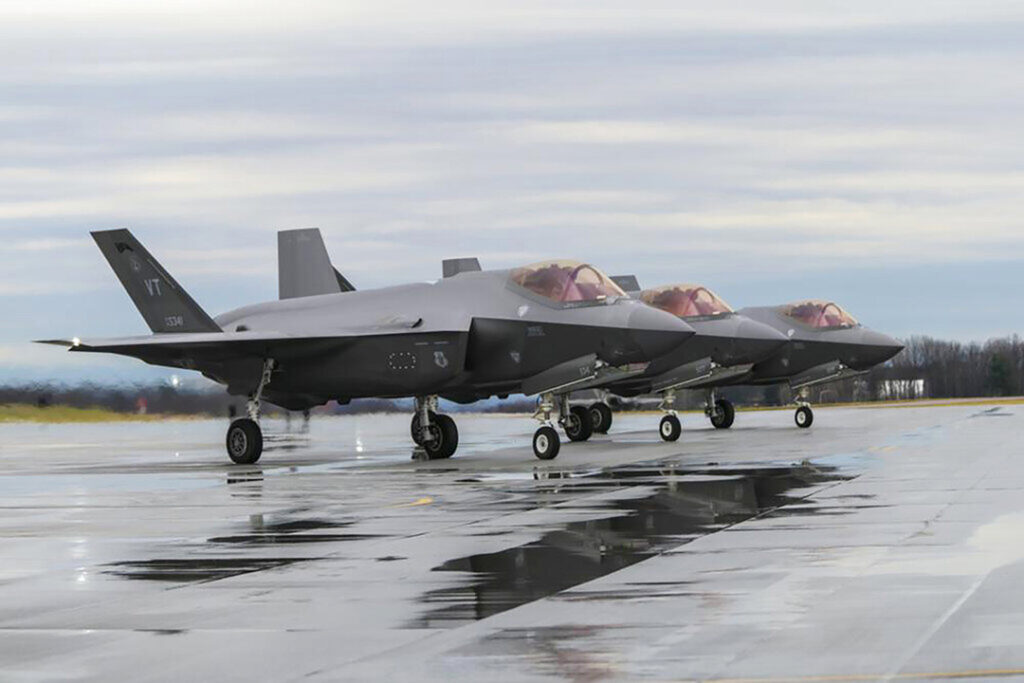THE ASSOCIATED PRESS
The first overseas deployment of the Vermont Air National Guard’s F-35 fighter jets will have the pilots and their aircraft patrolling the skies of Europe during a period of heightened tension.
More than 200 Vermont Air Guard personnel, their equipment and eight F-35s are now in Europe, where the pilots will fly enhanced air policing missions along NATO’s eastern flank to monitor the area for intrusions by Russian aircraft.
The deployment marks the first time the Vermont Air National Guard, the first guard unit in the country to fly F-35s, has deployed overseas with the U.S. Air Force’s newest warplane.
The deployment comes only months after the Vermont guard had completed its conversion from F-16s to the F-35s, which began arriving in Vermont in September 2019.
“We’re there to defend NATO,” said F-35 pilot Lt. Col John “Rocky” MacRae, a squadron commander within the Vermont Guard’s 158th Fighter Wing. “We’re not there to be aggressive or start anything. We’re there to posture in defense of NATO and support our allies.”
The F-35s from Hill Air Force Base and the Vermont National Guard are among a small but growing number of F-35 units ready for combat.
NATO, the military alliance of 30 countries from Europe, the United States and Canada, was created in the aftermath of World War II to counter the military threat from the former Soviet Union. The Russian invasion of Ukraine has highlighted the importance of the alliance.
NATO says the enhanced air-policing mission is part of a broader series of measures introduced after Russia’s 2014 annexation of the Crimean peninsula from Ukraine. It involves a continuous presence of fighter aircraft and crews who are ready to react to airspace violations.
On April 29, NATO said it had scrambled jets in the preceding days to track and intercept Russian aircraft in the Baltic and Black sea regions. The Russian aircraft, which often do not transmit a radio code indicating their position and altitude, do not file flight plans or communicate with air traffic controllers, NATO says.
The alliance said the Russian aircraft never entered NATO airspace and that the “interceptions were conducted in a safe and routine manner.”
The Vermont aircraft now in Europe are replacing F-35s from Hill Air Force Base in Utah. Retired Maj. Gen. Donald Shepperd, a former head of the Air National Guard, said there is always a learning curve on a unit’s first deployment with a new aircraft, but he says the Vermont unit will adapt.
“They’re very capable of doing anything,” Shepperd said. “And they’re also in the best airplane, the best fighter that the United States Air Force has. That’s a real first for them to fly it, the first to deploy it and the first operational deployment.”
Shepperd said it highlights how the role of the Air National Guard has evolved from a time when guard units received old equipment to where it is now, playing a regular role in Air Force deployments with the newest equipment available.
The Air Force describes the F-35 as its fifth-generation fighter that combines stealth technology with the ability to carry out multiple missions. Different models are being built for the Air Force, Navy and Marines, and the jets are being sold to U.S. allies across the world. (Pictured: F-35 Lightning II aircraft assigned to the 158th Fighter Wing in Burlington, Vermont, prepare for takeoff on April 13, 2022.)
The F-35 program is also the U.S. military’s most expensive weapons system of all time, with an estimated total cost of U.S. $1.5 trillion over the expected half-century life of the program. The model of planes based in Vermont cost U.S. $94 million each.
IMAGE CREDIT: THE ASSOCIATED PRESS

